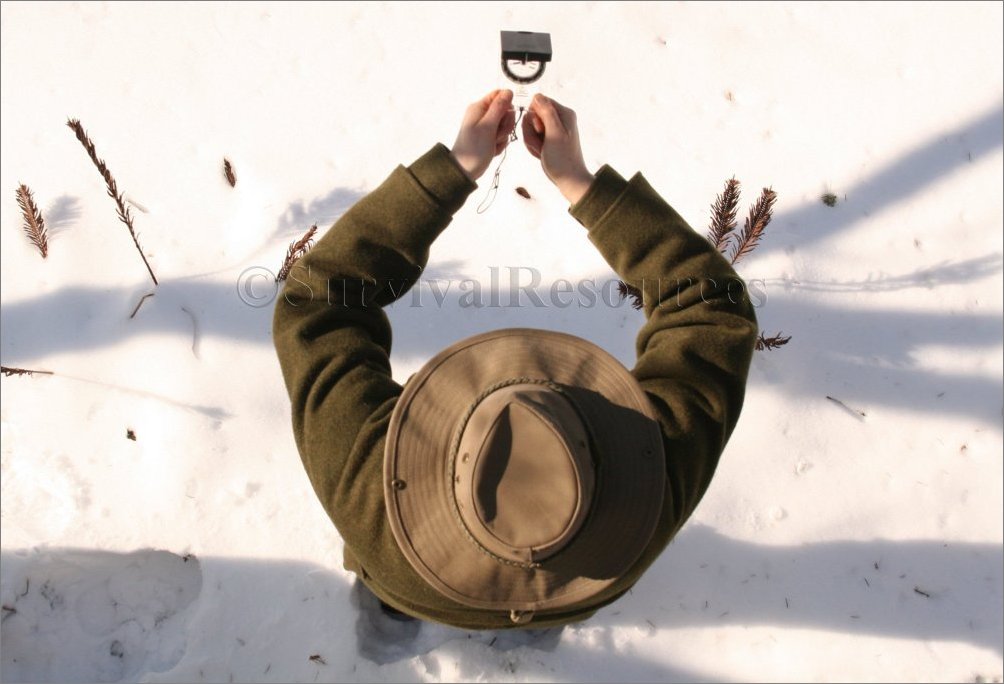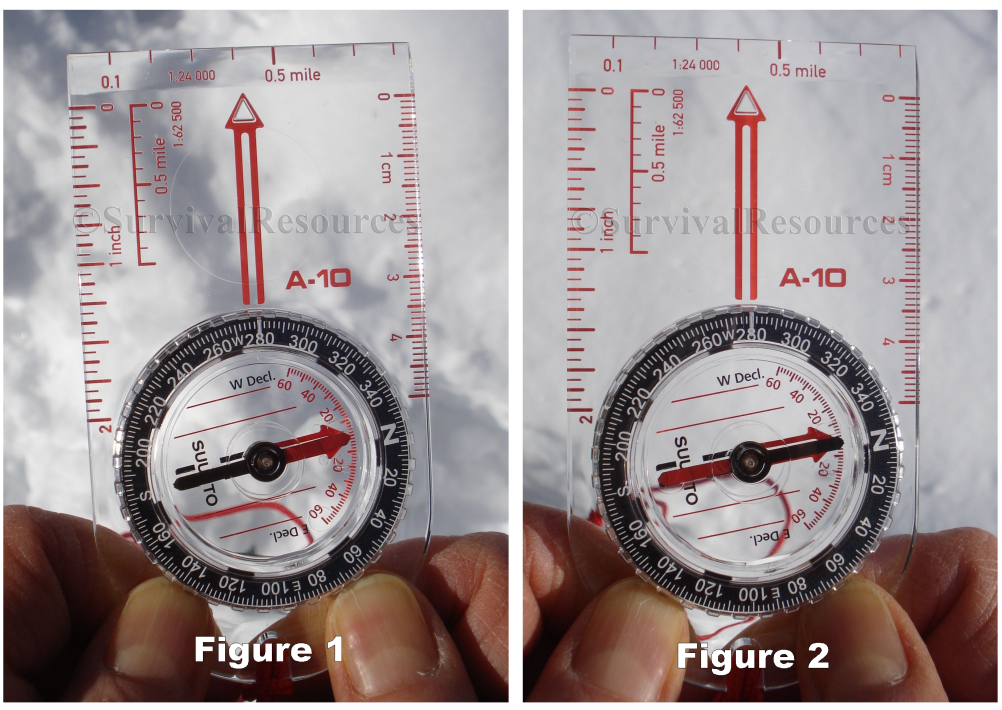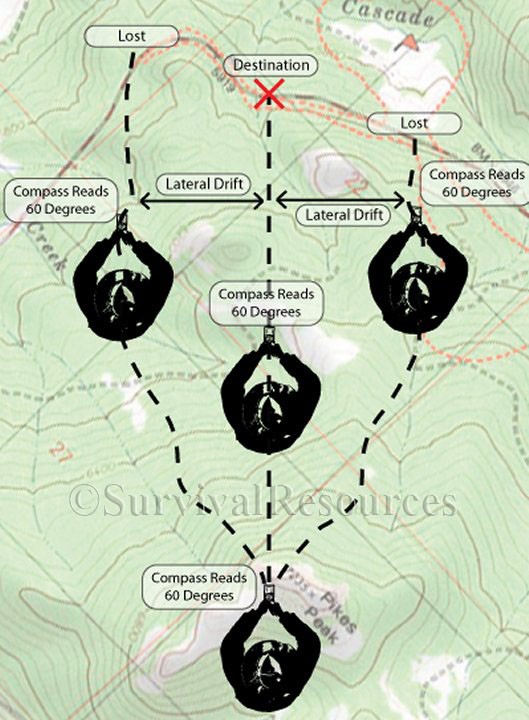- New Products
- Exclusive Gear
- Bushcraft Gear
- Containers
- Cooking
- Fire
- First Aid
- Food Gathering
- Knives & Tools
- Knife Collectors Corner
- Light
- Logo Gear
- Misc. Items
- Navigation
- Packs, Pouches & Bags
- Personal Care
- Repair Gear
- Shelter & Protection
- Signaling
- Urban Survival
- Water
- Writing Gear
- John's Books
- Bargain Bin
Staying Straight - Avoiding Lateral Drift

When traveling, using a compass, I always recommend making short runs, from one known point to another, if at all possible. When you site your compass on a known object, it is easier to accurately travel to that point. It is more accurate than trying to travel in a straight line with a known bearing, with nothing to site on.
It is easier to maintain a straight line if you can see both your starting point and the point you are traveling towards. A back bearing is a good way to check that you are traveling in a straight line, and can help prevent Lateral Drift. So first, let's discuss a back bearing.
A "Back" or "Reciprocal" bearing is the exact opposite as your main or forward bearing. If your main bearing is more than 180 degrees, you subtract 180 degrees from the main bearing. If it is less than 180 degrees, you add 180 degrees to the main bearing. Let's say you have sighted on a Fire Tower and know that it is a bearing of 300 degrees to that tower from your position. In this example, your main bearing to the fire tower is 300 degrees (which is more than 180 degrees) so you subtract 180 degrees which results in 120 degrees. Your back or reciprocal bearing is therefore 120 degrees, and in order to travel from the fire tower to your location, you would now travel at a main bearing of 120 degrees.
I have found that if you are using a fixed dial compass, the above calculations are required to determine your back bearing. However, if you are using a base-plate compass, there is an easier way. I have always believed that the more often you turn the rotating housing with dial, the greater chance you have of setting an inaccurate bearing. Therefore, with a base-plate compass, why calculate at all. Let's say that you are traveling at a main bearing of 280 degrees. Therefore the red end of the magnetic needle is boxed in the red end of the orienting needle (see Figure 1). When you need to check your back bearing, simply turn around, remaining on your direct line of travel, and place the red end of the magnetic needle in the black end of the orienting arrow (see Figure 2). The black end of the orienting needle is exactly 180 degrees from the red end. This prevents your having to turn the rotating housing from your main bearing, every time you want to check your back bearing while on the move.
 The compass on the left shows a bearing whereby the the red end of the magnetic needle is boxed in the red
The compass on the left shows a bearing whereby the the red end of the magnetic needle is boxed in the red
end of the orienting needle. The right compass shows the red end of the magnetic needle in the black end of
the orienting arrow. The black end of the orienting needle is exactly 180 degrees from the red end, providing
you a back bearing.
Now back to Lateral Drift. If you can mark your starting point with a stick in the ground, or another object, which you can see from a distance once you start moving forward, you can use it to determine if you have traveled straight forward. Using a back bearing, determine if you are pointing directly at your starting stick or object you left behind. If you are, you are moving straight ahead. If you are not, Lateral Drift has occurred, which means you have drifted to the left or right of the line of travel (see Diagram below).
 Diagram showing Lateral Drift.
Diagram showing Lateral Drift.
If lateral drift has occurred, there is one of two things you can do. The first is return to your last known point and re-shoot your bearing, aiming on an object directly in the bearings path, and try again to travel towards that target without drifting left or right. Another way, which is not as accurate, is to shuffle left or right of the direction of travel line until your "Back-Bearing" is aimed directly at the last starting point. Then carefully turn around, and continue on the original bearing.
If you are not traveling alone, you have two options. The first is to leave a person at the starting point. As you travel from the starting point, turn around, being careful that you remain on your line of travel. Using a back bearing, determine if you are pointing directly at the person left behind. If you are, you are moving straight ahead. Again, if you are not, Lateral Drift has occurred, which means you have drifted to the left or right of the line of travel.
My preferred way to operate when I have one other person is to get myself a stick and sharpen one end. I then tie an orange bandana or other item to the blunt end of the stick. I place the stick in the ground where I start. I then send the other person out so I can have them move left or right until they are on line with my bearing. I have them stand still and I just walk to them. When I get to them, I turn around and shoot a back bearing to the flag stick. If all is right and I have not drifted. I stand still and have the other person run back and get the flag. I then start over. Of course, this takes more time and more steps but provides a very accurate means of preventing lateral drift.
Of course, three people is ideal, but doesn't often happen. You can have one stay at the starting point. Another moves forward. The third person then uses the compass, standing in front of the first person and shoots a bearing. With a set bearing he has the person that has gone forward move left or right until he is in line with the bearing being shot. When the third person is in line with the bearing, the person with the compass can move to that person. He should then turn around and check his back bearing on the first person who stayed at the starting point. If all is good, you have the first person move forward to your position and start all over again.
You can see from the diagram, that even though you remain on the designated bearing, if you are careless and allow lateral drift to occur, you will not end up at the desired destination, but to the left or right of it. Even though the original bearing keeps you in a straight line forward, Lateral Drift takes you on a parallel course which does not lead to where you want to be.
Keep in mind that the more often you check your back bearing, the less likely you are to drift. As I have often been told, "Check your 6", and it goes without saying here!
Because of the difficulty in staying on a straight line when navigating with a compass, I often recommend Off-Shooting. Please check out my article on Baselines, Handrails, and Off-Shooting, as well as my article on Practical Exercises for Compass Accuracy.
We hope you enjoyed this article and will help support our efforts by checking out our products. As always, Be Prepared To Survive!
Copyright © 2016 by John D. McCann


